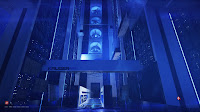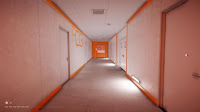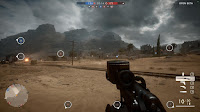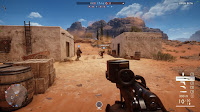Deus
Ex: Mankind Divided is the highly anticipated sequel to Human
Revolution. Set two years following the events of HR, Mankind Divided
sees the return of Adam Jensen, now working for Task Force 29 – an
anti-terrorist division within Interpol. As you would expect from a
Deus Ex title, it’s not long before Jensen finds himself caught
within a tangled web of conspiracy, surrounded by people he’s not
entirely sure he can trust.
The
game is divided into three primary acts – Prague (Day), Prague
(Night) and Prague (Curfew). Prague is the main ‘hub’ within
which many of the core and side missions occur. It’s split into two
areas, separated by a somewhat tedious load screen. Those expecting a
second hub or more locational variety may be disappointed, but the
Prague hub is far more extensive and complex than comparable areas in
Human Revolution.
Entry
to this hub is preceded by an opening tutorial mission set in Dubai.
There are also missions set in other locations at the end of every
act – Golem City, the Swiss Alps and London. Golem City is by far
the most complex, the Swiss Alps the least. These single missions do
provide a little taste of the globe trotting adventure you might
expect from a Deus Ex title, but as I said, those expecting multiple
hub areas may be disappointed.
And
I must admit, the Prague hub did begin to lose its appeal towards the
end of the game. The hub itself is fantastic, with an incredible
attention to detail and an extensive selection of side missions.
Exploring the hub is extremely rewarding with the chance to find
weapons, equipment or information that further serves to flesh out
the world, story and characters.
That
said, the hub does somewhat outstay its welcome by the third and
final act when the size of the hub, though impressive, does lead to a
lot of tedious running from A to B. This is especially irritating
when some of the final core and side quests require bouncing back and
forth between the two separate loading areas. And, to make matters
worse, Prague becomes a ‘hostile’ zone during the third act, so
simply getting about becomes something of a tedious chore.
The
ending of Human Revolution was arguably its weakest aspect, and
unfortunately the same is true of Mankind Divided. From the Swiss
Alps mission at the end of Act 2, through to the final mission in
London, everything feels rushed to a rather unsatisfying conclusion.
It’s a shame, because everything up until that point is absolutely
fantastic.
The
gameplay of Mankind Divided is essentially a more refined and
expanded version of that which we had in Human Revolution. With
multiple options for either non-lethal stealth, lethal stealth or a
combat oriented approach, Mankind Divided offers the gameplay variety
and player choice that you would expect.
Jensen’s
augmentations are expanded, offering new abilities both lethal and
non-lethal. The hacking mini-game is also expanded and refined. The
core gameplay of Mankind Divided is a near perfect refinement of
everything from Human Revolution. And, like Human Revolution, the
game has some fantastic level design both in the Prague hub and
single missions that allow the player to take multiple paths or
approaches to their objectives.
The
side content of Mankind Divided is excellent, with a variety of
substantial, multiple stage missions. Like the hub itself, these are
far more extensive than those in Human Revolution. In addition to the
side missions, there are also ‘points of interest’ that further
encourage exploration of the hub to uncover various secrets, tools
and upgrades.
Of
course, giving the player such freedom to explore the hub as they
please may result in them stumbling across mission related locations,
information or items earlier than they were intended. But the game
handles this aspect extremely well, so you’re free to to explore
without fear of ‘breaking’ any future missions.
The
majority of the game – the mission in Dubai, Prague (Day), Golem
City and Prague (Night) is fantastic. Great missions. Great level
design. Rewarding and enjoyable gameplay. Unfortunately, Mankind
Divided loses its way somewhat from the end of Act 2 onwards. The
Swiss Alps mission is disappointingly simple compared to the
complexity of Golem City. And the third act – Prague (Curfew) –
is a short and hurried act, artificially lengthened by the rather
pointless ‘hostile’ nature of the map.
This
leads onto the final mission in London. Thankfully, the final mission
is well designed and enjoyable from both a gameplay and story
perspective, but the game falls at the final hurdle by ending with a
rather lacklustre boss fight and an extremely short and unsatisfying
cut scene. It doesn’t wrap up much in terms of the various story
threads and just falls rather flat.
If
you were expecting all the clues and evidence you’ve been
collecting will lead to an ending that ties everything together,
you’ll be pretty disappointed. The ending feels rushed, with a
sudden switch of focus, rather convenient and hurried plot
developments, and no real feeling of achievement. Very little of what
is set up throughout the game, either in core or side quests, feels
like it pays off in any meaningful way as the game ends on an abrupt
cliffhanger. Which is why, in many ways, Mankind Divided feels like
only the first part of a larger story.
And
I’m totally fine with that, and I’d more than welcome another
Deus Ex game continuing Jensen’s story, but this game needed an
ending that offered much more to the player than it does. An ending
that tied together the various conspiracy threads into a satisfying
conclusion whilst also providing new revelations that set up another
sequel. As it is, the ending to Mankind Divided doesn’t really do
either. It just kind of stops.
I
won’t get into story specifics, but it’s an enjoyable tale, with
all the mystery, suspicion and conspiracies you’d expect. It also
deals more heavily with various social issues that are a direct
result of events in Human Revolution. Although a little heavy handed
at times, it deals with these issues in a fairly thoughtful and
engaging manner.
The
cast is good, and almost entirely new aside (obviously) from Jensen
and the reappearance of a key character from the original in an
important side mission. But I would’ve liked to have seen Pritchard
and Malik make a return.
Another
disappointing aspect with regards to the story is how few and short
the core missions are compared to Human Revolution. Whereas the bulk
of the content in HR revolved around its core story, the bulk of the
content in Mankind Divided is found in its side content and
exploration, not in its main story thread – which you could
probably breeze through quite easily in 6-8 hours. So although I
enjoyed the story, it’s not quite as substantial a campaign when
compared to the original, and the lacklustre ending makes it all feel
a little pointless.
Technically,
the game runs fine but not perfectly. I was running on a custom High
setting, and getting around 40-50 FPS. It could probably do with a
little further optimisation, but as long as you tweak the settings
appropriately to suit your system, performance shouldn’t be a major
issue.
Graphically,
Mankind Divided is a nice looking game, but character models appear a
little dated, and animations during conversations are still oddly
stiff. The game also ditches the infamous ‘piss filter’ of Human
Revolution. It never bothered me that much, but I can’t say I miss
it, and the new colour palette is more appropriate for the tone and
setting.
Outside
of its campaign, Mankind Divided also features a separate mini-game
mode called ‘Breach’ that sees you attempt to hack data from
within a virtual environment. It’s a rather pointless, if harmless
addition that seems tacked on to sell micro-transactions. In fact,
there are micro-transactions you can purchase during the campaign for
more credits or upgrade points.
I
don’t know why anyone would, as the game is finely balanced in
terms of player progression, and purchasing these items would break
that progression entirely. But the option is there, and all it’s
really going to do is piss people off. Micro-transactions in a single
player, full price release? I can’t imagine any profit they
actually make off this pointless addition will be worth the player
backlash.
When
it came to scoring Mankind Divided, I was close to giving the game a
solid 9. Despite my complaints, it’s an absolutely fantastic sequel
to Human Revolution and easily one of the best titles I’ve played
this year. But its core campaign isn’t as compelling or complete as
that in Human Revolution, and when I hit that lacklustre ending, it
felt like a right kick in the balls. But still, despite that
disappointing final act, Mankind Divided is quite easily in the
running for my personal Game of the Year and it comes highly
recommended.
8/10



























